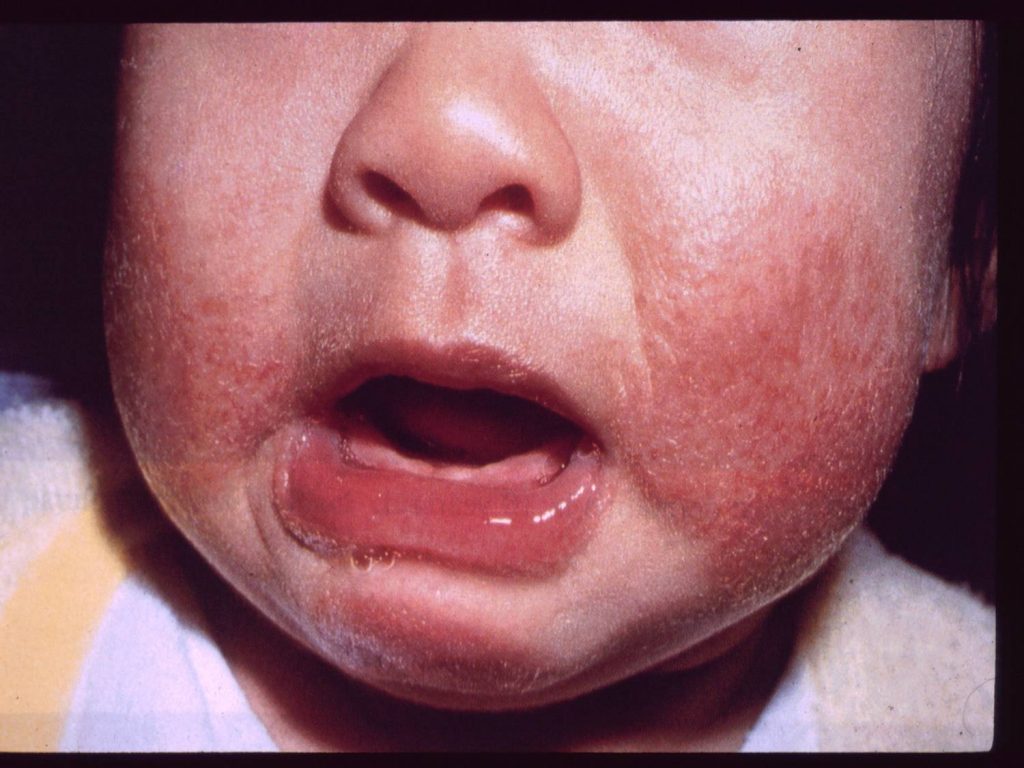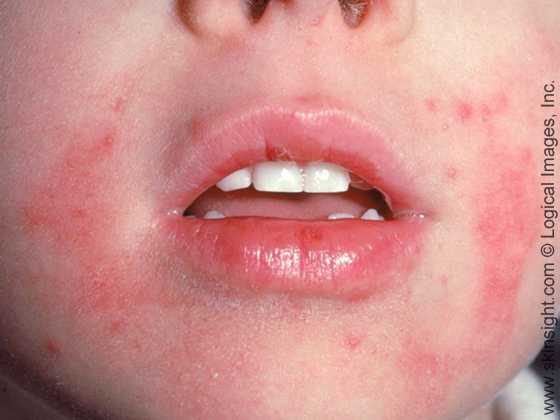Causes, symptoms, treatment and more
What is eczema?
Eczema (eg-zuh-MUH) is the name for a group of conditions that cause the skin to become red, itchy and inflamed.
There are several types of eczema. Atopic dermatitis, contact dermatitis, dyshidrotic eczema and seborrheic dermatitis, also known as “cradle cap” in infants, are the most common types that affect children. Eczema, especially atopic dermatitis, often appears in the first six months to five years of a child’s life.
Along with itchy skin, eczema can cause more severe allergies because it weakens the immune system, can cause blisters, and breaks down skin barriers that protect from skin disease. Luckily, both mild and more severe symptoms of eczema can be prevented and treated in babies and toddlers.
Why did my baby develop eczema?
What exactly causes eczema is unknown. Researchers don’t know why babies develop eczema, though they do know it’s due to a combination of environmental allergens and genetics. Eczema in babies can cause rashes on a baby’s skin, itchy skin and eczema flare-ups in the affected areas.
A variety of environmental factors can trigger eczema in infants, including certain cleansers, soaps and shampoos. Dry air and ointments can also trigger baby eczema.
If your baby suffers from eczema, consult with a pediatric dermatologist or qualified pediatrician. While they might prescribe a steroid, such as a topical corticosteroid, other steroid cream or an antihistamine, there’s other more natural treatments your healthcare provider could recommend. These can include over-the-counter medications, Vaseline petroleum jelly and fragrance-free products made for sensitive skin.
There are also some preventative measures your family can take as well to help prevent eczema flare-ups. Older infants can wear mittens and gloves to protect the affected areas against triggers. Food allergies can also cause flare-ups and you can create an eczema diet for your infant to reduce their effect. Using detergents and baby lotions that are better for this skin condition can also help.
To learn more about what products can prevent or treat eczema, check out these products that have the National Eczema Association’s Seal of AcceptanceTM.
Why did my toddler develop eczema?
Similar to when babies develop eczema, children who develop eczema do so because of a combination of genes and environmental triggers, but researchers don’t know a lot more about why eczema manifests on a child’s skin. When something outside the body “switches on” the immune system, skin cells don’t behave as they should causing eczema flare ups.
We also know that children who come from families with a history of eczema, asthma, or hay fever (known as the atopic triad) are more likely to develop atopic dermatitis.
Common eczema symptoms in children include itchiness, rashes and the breaking down of skin barriers that protect children from skin infections.
Prevention and treatment are often similar for toddlers and babies. No matter what age your child is, consult with a pediatrician or pediatric dermatologist before deciding on a treatment plan.
Treating eczema in babies and toddlers
Eczema is not contagious. You can’t “catch it” from someone else.
For most types of eczema, including atopic eczema, managing flares comes down to these basics:
- Know your child’s particular triggers to avoid exposure
- Implement a daily bathing and moisturizing routine to protect skin and lock in moisture
- Use over-the-counter (OTC) and prescription medication consistently and as prescribed to curb symptoms
There is no cure for eczema but there are treatments and more are coming. These include OTC remedies, prescription topical medications, phototherapy, and immunosuppressants.
Eczema, especially atopic dermatitis (AD), may look and act very differently as your child gets older. It’s important to understand which type of eczema they may have and their symptoms and triggers so that you can better treat and manage it as they grow and change. The only way to be sure what type of eczema your child has is to make an appointment with your doctor.
Is eczema different for infants, toddlers, and older children?

Eczema looks and acts differently in infants and toddlers than it does in older children. The location and appearance of eczema changes as they grow, so it’s important to know what to look for during every stage of your infant or toddler’s life.
Infants (first 6 months)
Eczema usually appears on the face, cheeks, chin, forehead and scalp. It can also spread to other areas of the body, but not usually in the diaper area, where moisture protects the skin. The skin at this stage also tends to look more red and “weepy.”
Babies (6-12 months)
At this stage, eczema often appears on your baby’s elbows and knees — places that are easy to scratch or rub as they’re crawling. If the eczema rash becomes infected, it may form a yellow crust, or very small, “pus bumps” on the skin.
Toddlers (2-5 years)

Atopic dermatitis frequently affects the face in children. It can appear as red patches with small bumps as shown here.
Around the age of two, your toddler’s eczema is more likely to appear in the creases of the elbows and knees, or on their wrists, ankles and hands. It may also appear on the skin around your toddler’s mouth and the eyelids. Your toddler’s skin may start to look dry and scaly at this stage and become thick with deeper lines — this is called “lichenification.”
Children (5 years+)
Eczema usually appears in the folds of the elbows and/or knees. Sometimes, it’s only on a child’s hands — at least 70% of people have had hand eczema at some time in their life. Redness and itchy patches behind your child’s ears, on their feet or scalp, may also be a sign of atopic dermatitis. But these could also be symptoms of another condition, like seborrheic dermatitis, which can exist with eczema.
What triggers my child’s eczema or causes it to get worse?
Some of the most common eczema triggers include:
- Dry skin
- Irritants
- Heat and sweating
- Infection
- Allergens such as pet dander, pollen or dust
Your child’s eczema may be worse in the winter when the air is dry. Saliva from drooling can also cause irritation on your baby’s cheeks, chin and neck.
The best way to manage your child’s eczema is by getting to know their symptoms and triggers so that you can help keep it under control.
Learn more about common eczema triggers.
What’s the difference between eczema and atopic dermatitis in children?
Eczema is an umbrella term for a group of conditions that cause the skin to become dry, itchy and inflamed. Dermatitis – literal meaning: skin inflammation – is another word for eczema.
Atopic dermatitis is one of the most common types of eczema, affecting 13% of all children under the age of 18 in the United States. Atopic dermatitis is considered a chronic, inflammatory condition that is a result of an overactive immune system response to triggers inside and outside the body.


